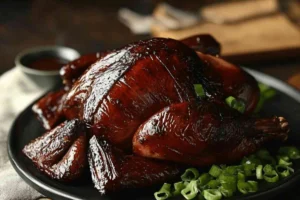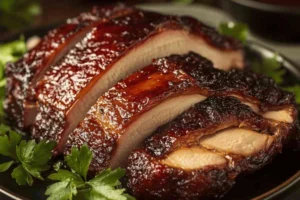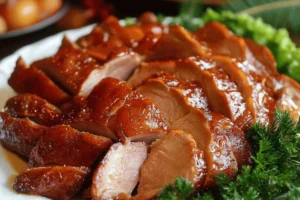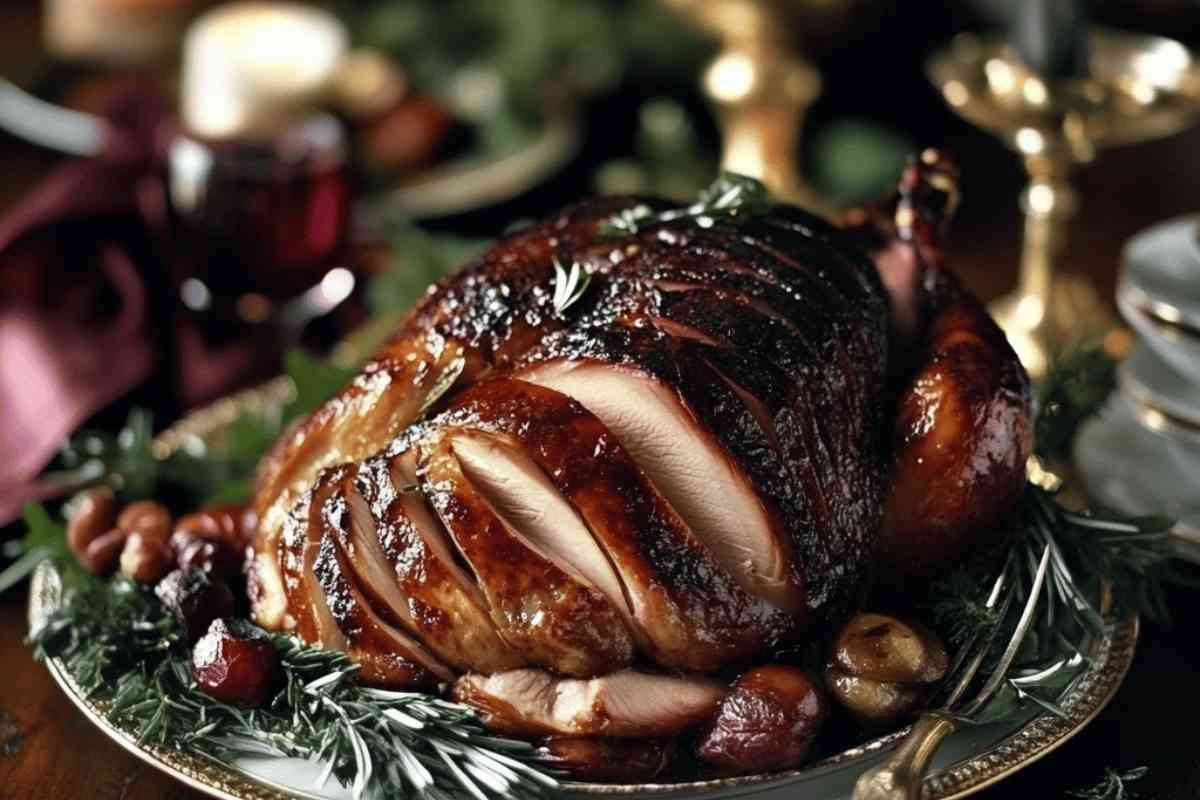Getting crispy skin on your smoked turkey is a goal for culinary excellence. It makes your turkey stand out from oven-baked ones. The crispy skin not only looks great but also tastes amazing.
Your guests will love the golden, crackling skin. It makes your turkey a highlight of the meal. To get that perfect skin, you need to know the right techniques and preparation.
In this article, we’ll show you how to achieve that irresistible crispy skin. You’ll learn how to make your smoked turkey skin perfect, leaving everyone wanting more.

Understanding the Importance of Crispy Skin
Crispy skin on a smoked turkey is very important. It makes the turkey look great and taste even better. The crispy skin adds a nice texture to the soft meat inside.
The skin helps keep the turkey moist and flavorful. It’s key to making your turkey skin crispy. To get crispy skin, you need to cook the turkey at high temperatures. This helps melt the fat and collagen in the skin.
Brining the turkey helps it stay moist and can make the skin crispy. You can use a big container for brining. Choose between wet or dry brining. Dry brining uses kosher salt and letting the turkey rest in the fridge.
For crispy skin, use a smoker at 275 degrees Fahrenheit. If you have a pellet grill, start at 250 degrees. Then, raise the heat to 375 degrees after a few hours. This temperature control is crucial for crispy skin.
Knowing how important crispy skin is will make your smoked turkey a hit. It will be the star of your meal.
The Best Turkey for Smoking
Choosing the right turkey for smoking is key to a great meal. A turkey between 10-14 pounds is perfect, serving 7-9 people. This size Secures even cooking and keeps everyone safe. Turkeys over 14 pounds might not cook evenly, which can be a problem.
Fresh turkeys are better than frozen ones for smoking. They taste better and soak up flavors better. This means your turkey will be juicy and full of flavor.
Invest in a good smoker like the Camp Chef 36 or the Traeger 780. These wood pellet smokers keep the temperature steady, which is important for smoking. An electric smoker is also a good choice because it keeps the temperature even.
Using the right wood can make your turkey taste amazing. Try using cherry and apple woods for a mild flavor. You can also mix mesquite and alder woods for a unique taste.
Here are some turkey smoking tips to help you:
- Start with a low temperature for the first part of smoking.
- Keep an eye on the turkey’s internal temperature to prevent overcooking.
- Butterflying or spatchcocking your turkey can make it cook faster and get crisper skin.
Brining: The Secret to Moisture and Flavor
Brining is key to a moist turkey that wows everyone. It involves soaking your turkey in a saltwater mix. This lets moisture deeply penetrate the meat, making it juicy and flavorful.
There are two main brining methods: wet and dry. Wet brining uses one cup of salt in one gallon of water. You soak your turkey in it for 12 to 24 hours. Dry brining, on the other hand, uses salt directly on the turkey’s skin. It’s left in the fridge to rest.
The magic of brining is osmosis. Salt in the brine breaks down proteins, letting water in. This makes your turkey’s skin crispy and the meat juicy.
Both wet and dry brining methods are effective. They boost your turkey’s flavor. A well-brined turkey tastes better and stays moist, even when smoked.
Preparing Your Turkey for Smoking
Getting your turkey ready for smoking is key to a delicious meal. Start by removing the giblets and drying the skin well. These steps help make the turkey juicy and the skin crispy, which is crucial for great flavor and texture.
Removing the Giblets
Begin by taking out the giblets from the turkey. These include the heart, liver, and neck. You can use them to make stock or gravy. Removing them makes the turkey look better and helps it cook evenly.
Drying the Skin
After removing the giblets, dry the turkey skin well. Dry skin is important for a crispy texture. Pat the skin dry with paper towels after brining. Then, coat it with oil to make it even crisper.

| Step | Description |
|---|---|
| 1. Remove Giblets | Take out heart, liver, and neck from the cavity to promote even cooking. |
| 2. Dry the Skin | Use paper towels to remove moisture after brining, then coat with oil. |
Smoking Techniques for Crispy Skin
To get crispy skin on your smoked turkey, the right techniques are key. Choosing the right smoker is crucial. Each smoker has its own benefits that can make your turkey taste and feel better.
Using the Right Smoker
The smoker you pick is very important for crispy turkey skin. Wood pellet grills and offset smokers keep the temperature steady. This even heat is important for cooking the turkey right.
Using a pastured organic turkey helps too. These turkeys don’t have additives found in other types. This makes them better to cook with.
Choosing the Best Wood for Smoking
The wood you use can change how your turkey tastes. Hickory, apple, cherry, pecan, and maple woods all add unique flavors. You can mix them to create your own taste.
| Wood Type | Flavor Notes | Best Pairing |
|---|---|---|
| Hickory | Strong, smoky flavor | Pairs well with high-fat meats |
| Apple Wood | Sweet and fruity | Improves poultry and pork |
| Cherry Wood | Subtle sweetness and rich color | Perfect for turkey and game birds |
| Pecan Wood | Rich, sweet, and nutty | Great with beef and turkey |
| Maple Wood | Mildly sweet smoke | Ideal for light meats like chicken |
Using these techniques and picking the right smoker will make your turkey amazing. The right wood will add delicious flavors. Your guests will love it.
How do you get the crispy skin on a smoked turkey?
To get crispy skin on a smoked turkey, you need to focus on temperature management and technique. First, cook the turkey at low temperatures. This lets the meat soak up the smoke flavor. Then, finish it off at a higher temperature for that crispy skin.
Low, Slow, Then Fast: Temperature Management
Start by cooking the turkey at 275°F. This lets it smoke for about three hours, soaking up flavors. Then, increase the temperature to 350°F. Keep cooking until the breast hits 165°F and the thigh hits 170°F. This way, the turkey stays juicy, and the skin gets crispy.
Spritzing vs. Basting
It’s important to know the difference between spritzing vs. basting turkey. Spritzing means lightly misting the turkey with a flavorful liquid during cooking. It keeps the turkey moist without making the skin soggy. Basting, which involves brushing the turkey with fat or juices, adds flavor but might make the skin soggy. Choose wisely to get the best results.

| Method | Benefits | Considerations |
|---|---|---|
| Temperature Management | Secures even cooking and flavors | Requires careful monitoring |
| Spritzing | Maintains moisture | May not contribute to skin crispiness |
| Basting | Adds flavor | Can lead to sogginess |
Finishing Touches: Achieving Perfectly Crisp Skin
After smoking your turkey, the final steps are key to crispy skin. The high-heat crisping method is perfect for this. It adds a brief high-temperature phase at the end.
High-Heat Crisping Method
To get the best turkey skin, follow these steps:
- Start by heating your oven or grill to 425°F just before your turkey is done. This high heat is crucial for crispiness.
- Remove the turkey from the smoker when it hits 160°F in the breast and 175°F in the thigh.
- Place the turkey on a wire rack over a baking sheet. This setup helps air circulate and crisp the skin evenly.
- Transfer the turkey to the preheated oven or grill. Cook for 10-15 minutes, watching it closely to avoid overcooking.
- Monitor the skin closely. Aim for a golden-brown finish to make your smoked turkey look great.
This high-heat method is vital for crispy skin. Remember to let your turkey rest for 20-30 minutes after cooking. This step lets juices spread evenly. But, covering it might soften the skin due to steam.
Resting Your Smoked Turkey
After working hard to make a tasty smoked turkey, you might want to cut it right away. But, it’s important to let it rest first. This step is key to a better dining experience. The importance of resting turkey is huge.
When you let your turkey rest for 20-30 minutes, the juices spread out. This makes the turkey moist and full of flavor. Plus, it keeps the skin crispy.
Importance of Resting Time
Knowing how important resting time is can make a big difference. If you don’t let the turkey rest, it can become dry. This ruins the meal’s enjoyment.
Resting the turkey makes it taste better and feel more tender. It Secures every bite is juicy and delicious. Here are some benefits of letting the turkey rest:
- Drawing moisture back into the meat, preventing dryness
- Enhancing the overall flavor profile through juiciness
- Maintaining the integrity of the crispy skin
- Providing a brief window for serving side dishes
Managing the resting time right makes your smoked turkey even better. It shows how crucial resting is in cooking.
| Resting Time | Benefits |
|---|---|
| 20-30 Minutes | Juice Redistribution |
| 20-30 Minutes | Moisture Retention |
| 20-30 Minutes | Crisp Skin Preservation |
| 20-30 Minutes | Flavor Improvement |
Side Dishes to Pair with Your Smoked Turkey
Adding the right side dishes to your smoked turkey meal makes it even better. Many side dishes can Improve the flavors of smoked turkey, making your meal complete. Here are some great options to try:
Classic and Comforting Options
- Creamy Mashed Potatoes: A timeless choice, perfect for Thanksgiving.
- Cornbread Stuffing: Brings a Southern flavor that complements the smokiness of the turkey.
- Mac and Cheese: A crowd-pleaser, combining creamy texture with savory notes from the turkey.
- Potato Gratin: Offers a creamy, luxurious texture that pairs beautifully with smoked turkey.
Vegetable-Based Sides
- Roasted Root Vegetables: Sweet potatoes, carrots, and parsnips add a sweet, earthy taste.
- Brussels Sprouts with Bacon: A mix of charred bitterness and savory richness.
- Grilled Asparagus with Lemon: Adds a bright, crisp contrast to the richness of smoked turkey.
- Garlic Parmesan Green Beans: Brings zest and richness to the table.
- Honey-Glazed Carrots: A sweet, caramelized touch of luxury.
Fresh and Light Options
- Apple and Walnut Salad: Refreshes the palate with sweetness and crunch.
- Coleslaw with Apple Cider Vinegar: Tangy and crunchy, balancing the smokiness of the turkey.
- Pickled Vegetables: Offers a tangy crunch between bites, perfect for palate cleansing.
Hearty and Unique Choices
- Wild Rice Pilaf: With cranberries and pecans, it’s a hearty yet light side dish.
- Roasted Cauliflower with Tahini: Adds an exotic flair with nutty flavors.
- Spicy Mustard Greens: Sautéed with garlic, offering a bold, bitter note.
- Grilled Corn on the Cob: A sweet, smoky side Improved with butter and seasoning.
Decadent and Festive Additions
- Baked Sweet Potato Casserole: With marshmallows or pecans for a rich, decadent touch.
- Butternut Squash Soup: Creamy and sweet, enhancing the turkey’s earthiness.
- Herbed Dinner Rolls: Infused with rosemary or thyme, perfect for soaking up turkey juices.
These diverse side dishes create a welcoming atmosphere while perfectly complementing smoked turkey. Mix and match flavors and textures to make a delightful feast!
Conclusion
Getting that perfect smoked turkey is all about preparation and technique. Start by picking the best turkey and brining it. Then, use the right smoking methods. Each step is crucial.
Using a dry brine, letting the turkey air-dry, and basting well can make a big difference. This way, you get a juicy turkey with crispy skin.
Many techniques can lead to a delicious turkey. Season the skin with oil and spices, chill it for 24 hours, and baste while cooking. This makes the turkey taste amazing.
For a great smoked turkey, smoke at the right temperature and use aromatic woods like pecan. This adds a unique flavor.
Understanding the preparation process is key to a successful smoke. By following these tips, you can impress everyone with a perfectly cooked turkey. Your next gathering will be unforgettable with your expertly smoked turkey!
FAQ
How do you get crispy skin in a smoker?
To achieve crispy skin in a smoker, dry the turkey thoroughly before seasoning and smoking. Allow it to air-dry in the refrigerator for at least 12–24 hours. Use a higher cooking temperature (around 325–350°F) towards the end of smoking to render the fat under the skin and crisp it up. Avoid basting with liquids during the process, as moisture can prevent the skin from crisping.
What is the secret to crispy turkey skin?
The secret to crispy turkey skin lies in proper preparation and cooking:
- Pat the turkey skin completely dry with paper towels.
- Let the turkey air-dry uncovered in the refrigerator overnight.
- Apply oil or melted butter generously to the skin to promote browning.
- Cook at a higher temperature (325–350°F) or finish with a quick broil to crisp the skin.
Why is my smoked turkey dry?
A smoked turkey can become dry if:
- It’s overcooked. Use a meat thermometer to check for doneness (165°F for the breast, 175°F for the thighs).
- It’s not brined or injected with a marinade. Brining helps retain moisture during smoking.
- The smoker temperature is too high or the turkey was smoked for too long. Keep your smoker at a steady 225–250°F for consistent results.
How do you keep turkey skin from turning black when smoking?
To prevent turkey skin from turning black during smoking:
- Avoid using too much wood or strong-flavored woods that produce heavy smoke, which can darken the skin.
- Wrap the turkey in foil if it’s reaching a deep color too quickly.
- Smoke at a moderate temperature (225–250°F) and avoid prolonged exposure to smoke after the first few hours.
- Monitor closely during the final cooking phase to prevent over-smoking.

